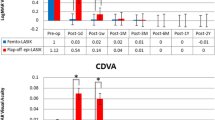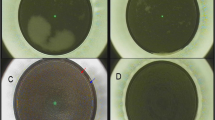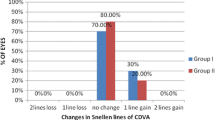Abstract
Background
To investigate the association between femtosecond laser flap parameters, uncorrected distance visual acuity, and higher-order aberrations (HOA) after customized myopic LASIK.
Methods
Retrospective review of the charts of patients who underwent uncomplicated wavefront-guided customized myopic LASIK with flap creation using the femtosecond laser. Patients were stratified by intended flap thickness, and the change in HOA from preoperative to 3 months postoperative was compared. Multivariate linear models were performed to assess the association between calculated flap thickness, intended flap diameter, HOA, and uncorrected visual acuity.
Results
One hundred seventy-one eyes of 171 patients were included. There was no statistically significant difference in the induction of HOA between eyes with thin (90 μm) or thick (100 or 110 μm) intended flaps. In a multivariate model, the level of myopic correction was highly associated with the induction of total HOA, coma, and spherical aberration. There was no correlation between calculated flap thickness, uncorrected visual acuity, or HOAs. Intended flap diameter was not associated with coma or spherical aberration, but larger flap diameter was associated with better uncorrected visual acuity.
Conclusions
Femtosecond laser flap thickness in the range of 90–110 μm was not associated with uncorrected visual acuity or the induction of HOA after uncomplicated customized myopic LASIK. The level of myopic correction was the largest determinant of the induction of HOA.


Similar content being viewed by others
References
Miller JM, Anwaruddin R, Straub J, Schwiegerling J (2002) Higher-order aberrations in normal, dilated, intraocular lens, and laser in situ keratomileusis corneas. J Refract Surg 18:S579–S583
Moreno-Barriuso E, Lloves JM, Marcos S, Navarro R, Llorente L, Barbero S (2001) Ocular aberrations before and after myopic corneal refractive surgery: LASIK-induced changes measured with laser ray tracing. Invest Ophthalmol Vis Sci 42:1396–1403
Mrochen M, Kaemmerer M, Mierdel P, Seiler T (2001) Increased higher-order optical aberrations after laser refractive surgery: a problem of subclinical decentration. J Cataract Refract Surg 27:362–369
Pesudovs K (2005) Wavefront aberration outcomes of LASIK for high myopia and high hyperopia. J Refract Surg 21:S508–S512
Anera RG, Villa C, Jimenez JR, Gutierrez R (2009) Effect of LASIK and contact lens corneal refractive therapy on higher-order aberrations and contrast sensitivity function. J Refract Surg 25:277–284
Yamane N, Miyata K, Samejima T, Hiraoka T, Kiuchi T, Okamoto F, Hirohara Y, Mihashi T, Oshika T (2004) Ocular higher-order aberrations and contrast sensitivity after conventional laser in situ keratomileusis. Invest Ophthalmol Vis Sci 45:3986–3990
Chalita MR, Chavala S, Xu M, Krueger RR (2004) Wavefront analysis in post-LASIK eyes and its correlation with visual symptoms, refraction, and topography. Ophthalmology 111:447–453
Chalita MR, Xu M, Krueger RR (2003) Correlation of aberrations with visual symptoms using wavefront analysis in eyes after laser in situ keratomileusis. J Refract Surg 19:S682–S686
Sharma M, Wachler BS, Chan CC (2007) Higher-order aberrations and relative risk of symptoms after LASIK. J Refract Surg 23:252–256
Porter J, MacRae S, Yoon G, Roberts C, Cox IG, Williams DR (2003) Separate effects of the microkeratome incision and laser ablation on the eye's wave aberration. Am J Ophthalmol 136:327–337
Pallikaris IG, Kymionis GD, Panagopoulou SI, Siganos CS, Theodorakis MA, Pallikaris AI (2002) Induced optical aberrations following formation of a laser in situ keratomileusis flap.[see comment]. J Cataract Refract Surg 28:1737–1741
Potgieter FJ, Roberts C, Cox IG, Mahmoud AM, Herderick EE, Roetz M, Steenkamp W (2005) Prediction of flap response. J Cataract Refract Surg 31:106–114
Waheed S, Chalita MR, Xu M, Krueger RR (2005) Flap-induced and laser-induced ocular aberrations in a two-step LASIK procedure. J Refract Surg 21:346–352
Guell JL, Velasco F, Roberts C, Sisquella MT, Mahmoud A (2005) Corneal flap thickness and topography changes induced by flap creation during laser in situ keratomileusis. J Cataract Refract Surg 31:115–119
Kezirian GM, Stonecipher KG (2004) Comparison of the IntraLase femtosecond laser and mechanical keratomes for laser in situ keratomileusis. J Cataract Refract Surg 30:804–811
Tran DB, Sarayba MA, Bor Z, Garufis C, Duh YJ, Soltes CR, Juhasz T, Kurtz RM (2005) Randomized prospective clinical study comparing induced aberrations with IntraLase and Hansatome flap creation in fellow eyes: potential impact on wavefront-guided laser in situ keratomileusis. J Cataract Refract Surg 31:97–105
Krueger RR, Dupps WJ Jr (2007) Biomechanical effects of femtosecond and microkeratome-based flap creation: prospective contralateral examination of two patients. J Refract Surg 23:800–807
Montes-Mico R, Rodriguez-Galietero A, Alio JL (2007) Femtosecond laser versus mechanical keratome LASIK for myopia. Ophthalmology 114:62–68
Medeiros FW, Stapleton WM, Hammel J, Krueger RR, Netto MV, Wilson SE (2007) Wavefront analysis comparison of LASIK outcomes with the femtosecond laser and mechanical microkeratomes. J Refract Surg 23:880–887
Cheng ZY, He JC, Zhou XT, Chu RY (2008) Effect of flap thickness on higher-order wavefront aberrations induced by LASIK: a bilateral study. J Refract Surg 24:524–529
Hosny M, Awadalla MA (2008) Comparison of higher-order aberrations after LASIK using disposable microkeratome 130 and 90 micron heads. Eur J Ophthalmol 18:332–337
Moshirfar M, Hatch BB, Chang JC, Kurz CJ, Eugarrios MF, Mifflin MD (2011) Prospective, contralateral comparison of 120-mum and 90-mum LASIK flaps using the IntraLase FS60 femtosecond laser. J Refract Surg 27:251–259
Subbaram MV, MacRae S, Slade SG, Durrie DS (2006) Customized LASIK treatment for myopia: relationship between preoperative higher-order aberrations and refractive outcome. J Refract Surg 22:746–753
Moshirfar M, Schliesser JA, Chang JC, Oberg TJ, Mifflin MD, Townley R, Livingston MK, Kurz CJ (2010) Visual outcomes after wavefront-guided photorefractive keratectomy and wavefront-guided laser in situ keratomileusis: Prospective comparison. J Cataract Refract Surg 36:1336–1343
Keir NJ, Simpson T, Jones LW, Fonn D (2009) Wavefront-guided LASIK for myopia: effect on visual acuity, contrast sensitivity, and higher-order aberrations. J Refract Surg 25:524–533
Moshirfar M, Espandar L, Meyer JJ, Tanner JR, Holz HA (2007) Prospective randomized trial of wavefront-guided laser in situ keratomileusis with the CustomCornea and CustomVue laser systems. J Cataract Refract Surg 33:1727–1733
Caster AI, Hoff JL, Ruiz R (2005) Conventional vs wavefront-guided LASIK using the LADARVision4000 excimer laser. J Refract Surg 21:S786–S791
Schallhorn SC, Farjo AA, Huang D, Boxer Wachler BS, Trattler WB, Tanzer DJ, Majmudar PA, Sugar A (2008) Wavefront-guided LASIK for the correction of primary myopia and astigmatism a report by the American Academy of Ophthalmology. Ophthalmology 115:1249–1261
Lopez-Miguel A, Maldonado MJ, Belzunce A, Barrio-Barrio J, Coco-Martin MB, Nieto JC (2012) Precision of a commercial Hartmann–Shack aberrometer: limits of total wavefront laser vision correction. Am J Ophthalmol 154(799–807):e795
Buhren J, Kohnen T (2006) Factors affecting the change in lower-order and higher-order aberrations after wavefront-guided laser in situ keratomileusis for myopia with the Zyoptix 3.1 system. J Cataract Refract Surg 32:1166–1174
Dupps WJ Jr, Roberts C (2001) Effect of acute biomechanical changes on corneal curvature after photokeratectomy. J Refract Surg 17:658–669
Murakami Y, Manche EE (2011) Comparison of intraoperative subtraction pachymetry and postoperative anterior segment optical coherence tomography of laser in situ keratomileusis flaps. J Cataract Refract Surg
Bahar I, Levinger S, Kremer I (2007) Wavefront-guided LASIK for myopia with the Technolas 217z: results at 3 years. J Refract Surg 23:586–590, discussion 591
Lin JM, Tsai YY (2005) Laser in situ keratomileusis for different degrees of myopia. Acta Ophthalmol Scand 83:40–45
Brint SF (2005) Higher-order aberrations after LASIK for myopia with Alcon and Wavelight lasers: a prospective randomized trial. J Refract Surg 21:S799–S803
Venter J (2005) Wavefront-guided LASIK with the NIDEK NAVEX platform for the correction of myopia and myopic astigmatism with 6-month follow-up. J Refract Surg 21:S640–S645
Hersh PS, Steinert RF, Brint SF (2000) Photorefractive keratectomy versus laser in situ keratomileusis: comparison of optical side effects. Summit PRK-LASIK Study Group. Ophthalmology 107:925–933
Hersh PS, Fry KL, Bishop DS (2003) Incidence and associations of retreatment after LASIK. Ophthalmology 110:748–754
Hu DJ, Feder RS, Basti S, Fung BB, Rademaker AW, Stewart P, Rosenberg MA (2004) Predictive formula for calculating the probability of LASIK enhancement. J Cataract Refract Surg 30:363–368
Netto MV, Wilson SE (2004) Flap lift for LASIK retreatment in eyes with myopia. Ophthalmology 111:1362–1367
Ghanem RC, de la Cruz J, Tobaigy FM, Ang LP, Azar DT (2007) LASIK in the presbyopic age group: safety, efficacy, and predictability in 40- to 69-year-old patients. Ophthalmology 114:1303–1310
Knox Cartwright NE, Tyrer JR, Marshall J (2011) Age-related differences in the elasticity of the human cornea. Invest Ophthalmol Vis Sci 52:4324–4329
Elsheikh A, Wang D, Brown M, Rama P, Campanelli M, Pye D (2007) Assessment of corneal biomechanical properties and their variation with age. Curr Eye Res 32:11–19
Rocha KM, Kagan R, Smith SD, Krueger RR (2009) Thresholds for interface haze formation after thin-flap femtosecond laser in situ keratomileusis for myopia. Am J Ophthalmol 147:966–972, 972 e961
Conflicts of interest and source of funding
Dr. Krueger is a consultant for Alcon, Ft. Worth, TX. For the remaining authors, there are no conflicts of interest.
Author information
Authors and Affiliations
Corresponding author
Rights and permissions
About this article
Cite this article
Hood, C.T., Krueger, R.R. & Wilson, S.E. The association between femtosecond laser flap parameters and ocular aberrations after uncomplicated custom myopic LASIK. Graefes Arch Clin Exp Ophthalmol 251, 2155–2162 (2013). https://doi.org/10.1007/s00417-013-2328-1
Received:
Revised:
Accepted:
Published:
Issue Date:
DOI: https://doi.org/10.1007/s00417-013-2328-1




